Political Cartoons: Chinese Immigration and the Exclusion Act
VerifiedAdded on 2023/06/10
|18
|2634
|484
Essay
AI Summary
This essay examines Chinese immigration to America, focusing on the period leading up to the Chinese Exclusion Act of 1882. It discusses the initial acceptance of Chinese laborers during the California Gold Rush and subsequent large-scale labor projects, followed by growing resentment due to economic downturns and competition for jobs. The essay highlights the role of satirical political cartoons in perpetuating negative stereotypes of Chinese immigrants as a threat to American society. These cartoons contributed to a climate of hostility that ultimately led to the enactment of the Chinese Exclusion Act, effectively barring Chinese immigration. The essay includes several examples of such illustrations and posters from the era, demonstrating the prevailing anti-Chinese sentiment and its impact on immigration policy. The appendix includes the images of the posters referenced in the essay.
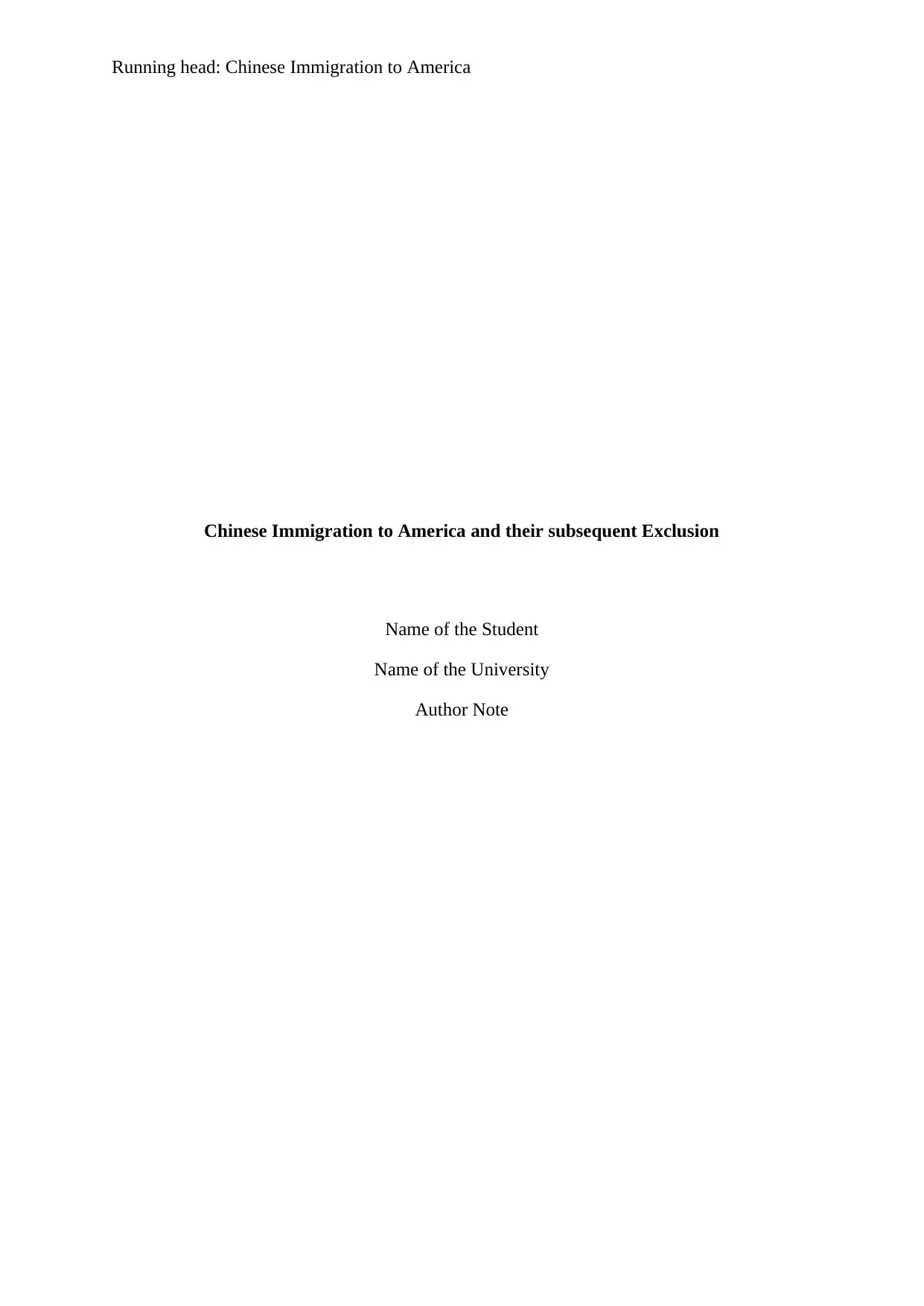
Running head: Chinese Immigration to America
Chinese Immigration to America and their subsequent Exclusion
Name of the Student
Name of the University
Author Note
Chinese Immigration to America and their subsequent Exclusion
Name of the Student
Name of the University
Author Note
Paraphrase This Document
Need a fresh take? Get an instant paraphrase of this document with our AI Paraphraser
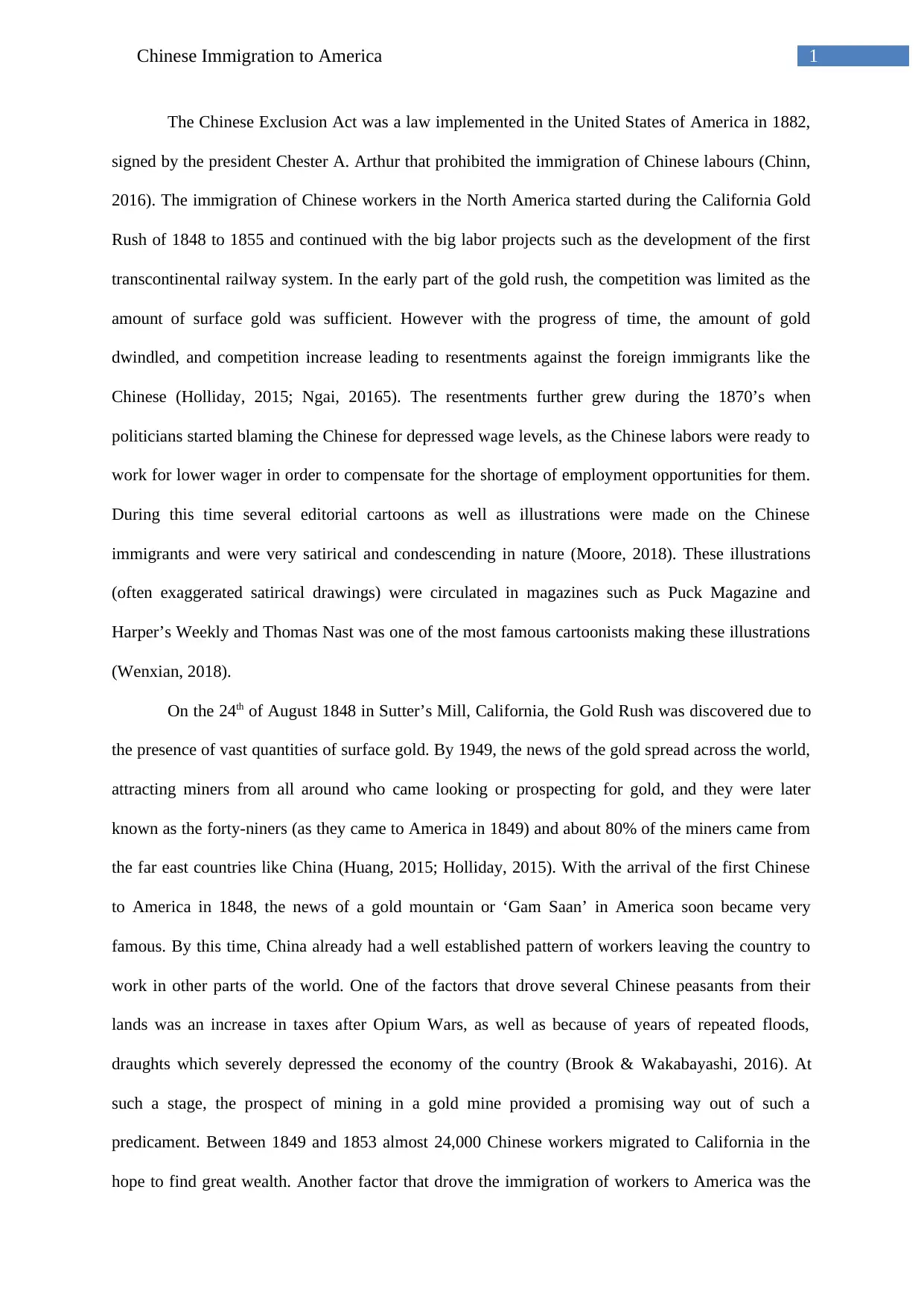
1Chinese Immigration to America
The Chinese Exclusion Act was a law implemented in the United States of America in 1882,
signed by the president Chester A. Arthur that prohibited the immigration of Chinese labours (Chinn,
2016). The immigration of Chinese workers in the North America started during the California Gold
Rush of 1848 to 1855 and continued with the big labor projects such as the development of the first
transcontinental railway system. In the early part of the gold rush, the competition was limited as the
amount of surface gold was sufficient. However with the progress of time, the amount of gold
dwindled, and competition increase leading to resentments against the foreign immigrants like the
Chinese (Holliday, 2015; Ngai, 20165). The resentments further grew during the 1870’s when
politicians started blaming the Chinese for depressed wage levels, as the Chinese labors were ready to
work for lower wager in order to compensate for the shortage of employment opportunities for them.
During this time several editorial cartoons as well as illustrations were made on the Chinese
immigrants and were very satirical and condescending in nature (Moore, 2018). These illustrations
(often exaggerated satirical drawings) were circulated in magazines such as Puck Magazine and
Harper’s Weekly and Thomas Nast was one of the most famous cartoonists making these illustrations
(Wenxian, 2018).
On the 24th of August 1848 in Sutter’s Mill, California, the Gold Rush was discovered due to
the presence of vast quantities of surface gold. By 1949, the news of the gold spread across the world,
attracting miners from all around who came looking or prospecting for gold, and they were later
known as the forty-niners (as they came to America in 1849) and about 80% of the miners came from
the far east countries like China (Huang, 2015; Holliday, 2015). With the arrival of the first Chinese
to America in 1848, the news of a gold mountain or ‘Gam Saan’ in America soon became very
famous. By this time, China already had a well established pattern of workers leaving the country to
work in other parts of the world. One of the factors that drove several Chinese peasants from their
lands was an increase in taxes after Opium Wars, as well as because of years of repeated floods,
draughts which severely depressed the economy of the country (Brook & Wakabayashi, 2016). At
such a stage, the prospect of mining in a gold mine provided a promising way out of such a
predicament. Between 1849 and 1853 almost 24,000 Chinese workers migrated to California in the
hope to find great wealth. Another factor that drove the immigration of workers to America was the
The Chinese Exclusion Act was a law implemented in the United States of America in 1882,
signed by the president Chester A. Arthur that prohibited the immigration of Chinese labours (Chinn,
2016). The immigration of Chinese workers in the North America started during the California Gold
Rush of 1848 to 1855 and continued with the big labor projects such as the development of the first
transcontinental railway system. In the early part of the gold rush, the competition was limited as the
amount of surface gold was sufficient. However with the progress of time, the amount of gold
dwindled, and competition increase leading to resentments against the foreign immigrants like the
Chinese (Holliday, 2015; Ngai, 20165). The resentments further grew during the 1870’s when
politicians started blaming the Chinese for depressed wage levels, as the Chinese labors were ready to
work for lower wager in order to compensate for the shortage of employment opportunities for them.
During this time several editorial cartoons as well as illustrations were made on the Chinese
immigrants and were very satirical and condescending in nature (Moore, 2018). These illustrations
(often exaggerated satirical drawings) were circulated in magazines such as Puck Magazine and
Harper’s Weekly and Thomas Nast was one of the most famous cartoonists making these illustrations
(Wenxian, 2018).
On the 24th of August 1848 in Sutter’s Mill, California, the Gold Rush was discovered due to
the presence of vast quantities of surface gold. By 1949, the news of the gold spread across the world,
attracting miners from all around who came looking or prospecting for gold, and they were later
known as the forty-niners (as they came to America in 1849) and about 80% of the miners came from
the far east countries like China (Huang, 2015; Holliday, 2015). With the arrival of the first Chinese
to America in 1848, the news of a gold mountain or ‘Gam Saan’ in America soon became very
famous. By this time, China already had a well established pattern of workers leaving the country to
work in other parts of the world. One of the factors that drove several Chinese peasants from their
lands was an increase in taxes after Opium Wars, as well as because of years of repeated floods,
draughts which severely depressed the economy of the country (Brook & Wakabayashi, 2016). At
such a stage, the prospect of mining in a gold mine provided a promising way out of such a
predicament. Between 1849 and 1853 almost 24,000 Chinese workers migrated to California in the
hope to find great wealth. Another factor that drove the immigration of workers to America was the
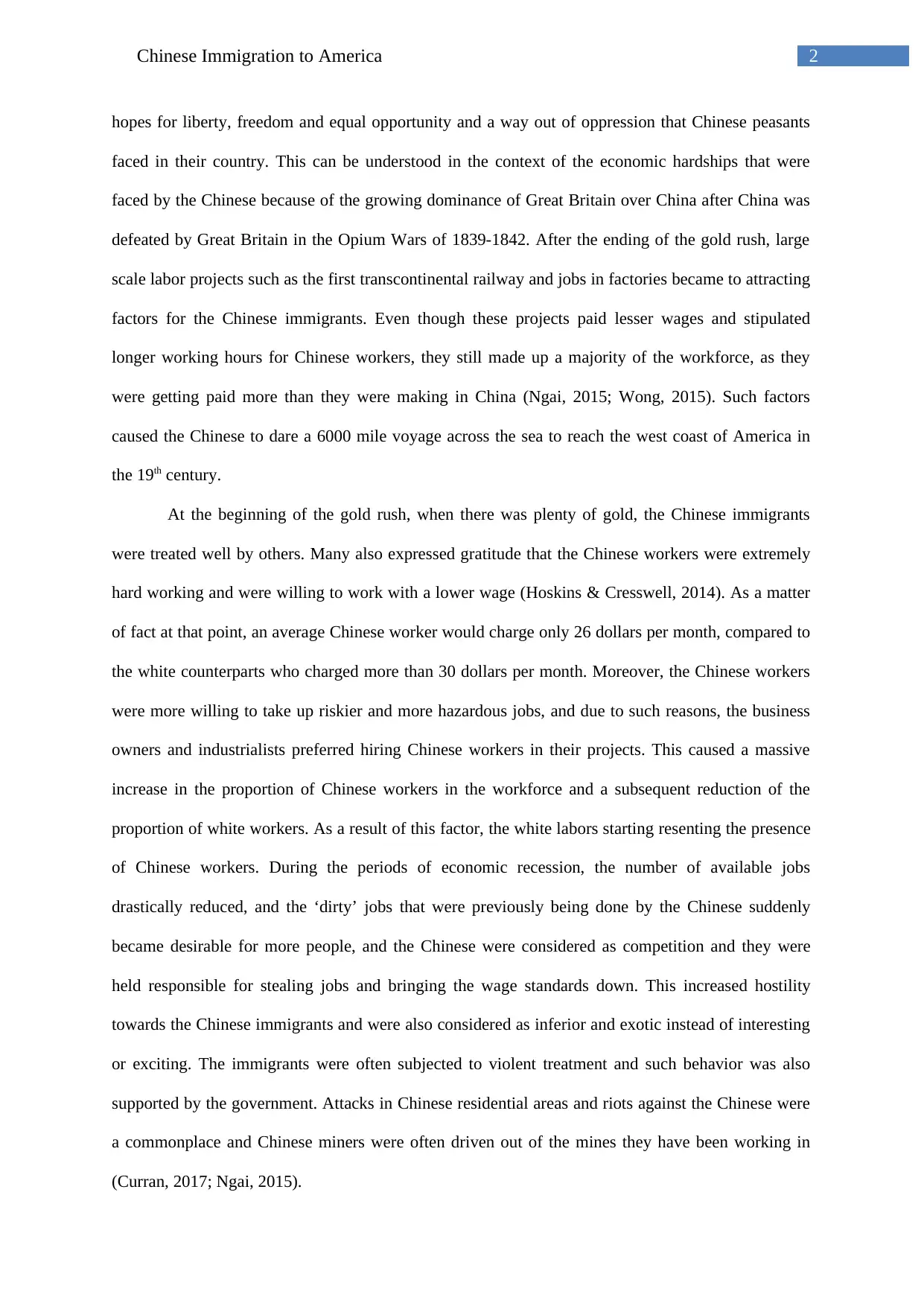
2Chinese Immigration to America
hopes for liberty, freedom and equal opportunity and a way out of oppression that Chinese peasants
faced in their country. This can be understood in the context of the economic hardships that were
faced by the Chinese because of the growing dominance of Great Britain over China after China was
defeated by Great Britain in the Opium Wars of 1839-1842. After the ending of the gold rush, large
scale labor projects such as the first transcontinental railway and jobs in factories became to attracting
factors for the Chinese immigrants. Even though these projects paid lesser wages and stipulated
longer working hours for Chinese workers, they still made up a majority of the workforce, as they
were getting paid more than they were making in China (Ngai, 2015; Wong, 2015). Such factors
caused the Chinese to dare a 6000 mile voyage across the sea to reach the west coast of America in
the 19th century.
At the beginning of the gold rush, when there was plenty of gold, the Chinese immigrants
were treated well by others. Many also expressed gratitude that the Chinese workers were extremely
hard working and were willing to work with a lower wage (Hoskins & Cresswell, 2014). As a matter
of fact at that point, an average Chinese worker would charge only 26 dollars per month, compared to
the white counterparts who charged more than 30 dollars per month. Moreover, the Chinese workers
were more willing to take up riskier and more hazardous jobs, and due to such reasons, the business
owners and industrialists preferred hiring Chinese workers in their projects. This caused a massive
increase in the proportion of Chinese workers in the workforce and a subsequent reduction of the
proportion of white workers. As a result of this factor, the white labors starting resenting the presence
of Chinese workers. During the periods of economic recession, the number of available jobs
drastically reduced, and the ‘dirty’ jobs that were previously being done by the Chinese suddenly
became desirable for more people, and the Chinese were considered as competition and they were
held responsible for stealing jobs and bringing the wage standards down. This increased hostility
towards the Chinese immigrants and were also considered as inferior and exotic instead of interesting
or exciting. The immigrants were often subjected to violent treatment and such behavior was also
supported by the government. Attacks in Chinese residential areas and riots against the Chinese were
a commonplace and Chinese miners were often driven out of the mines they have been working in
(Curran, 2017; Ngai, 2015).
hopes for liberty, freedom and equal opportunity and a way out of oppression that Chinese peasants
faced in their country. This can be understood in the context of the economic hardships that were
faced by the Chinese because of the growing dominance of Great Britain over China after China was
defeated by Great Britain in the Opium Wars of 1839-1842. After the ending of the gold rush, large
scale labor projects such as the first transcontinental railway and jobs in factories became to attracting
factors for the Chinese immigrants. Even though these projects paid lesser wages and stipulated
longer working hours for Chinese workers, they still made up a majority of the workforce, as they
were getting paid more than they were making in China (Ngai, 2015; Wong, 2015). Such factors
caused the Chinese to dare a 6000 mile voyage across the sea to reach the west coast of America in
the 19th century.
At the beginning of the gold rush, when there was plenty of gold, the Chinese immigrants
were treated well by others. Many also expressed gratitude that the Chinese workers were extremely
hard working and were willing to work with a lower wage (Hoskins & Cresswell, 2014). As a matter
of fact at that point, an average Chinese worker would charge only 26 dollars per month, compared to
the white counterparts who charged more than 30 dollars per month. Moreover, the Chinese workers
were more willing to take up riskier and more hazardous jobs, and due to such reasons, the business
owners and industrialists preferred hiring Chinese workers in their projects. This caused a massive
increase in the proportion of Chinese workers in the workforce and a subsequent reduction of the
proportion of white workers. As a result of this factor, the white labors starting resenting the presence
of Chinese workers. During the periods of economic recession, the number of available jobs
drastically reduced, and the ‘dirty’ jobs that were previously being done by the Chinese suddenly
became desirable for more people, and the Chinese were considered as competition and they were
held responsible for stealing jobs and bringing the wage standards down. This increased hostility
towards the Chinese immigrants and were also considered as inferior and exotic instead of interesting
or exciting. The immigrants were often subjected to violent treatment and such behavior was also
supported by the government. Attacks in Chinese residential areas and riots against the Chinese were
a commonplace and Chinese miners were often driven out of the mines they have been working in
(Curran, 2017; Ngai, 2015).
⊘ This is a preview!⊘
Do you want full access?
Subscribe today to unlock all pages.

Trusted by 1+ million students worldwide
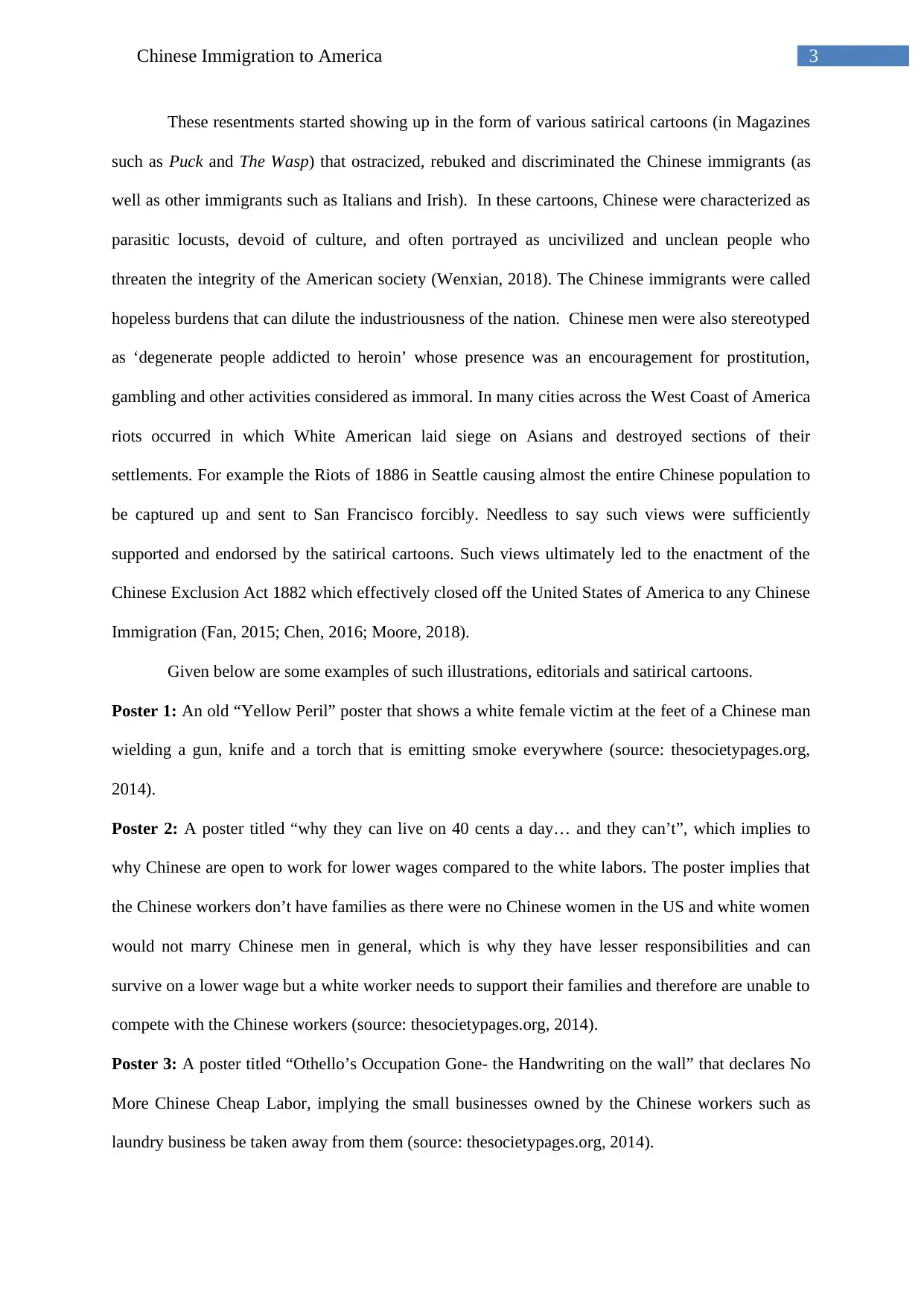
3Chinese Immigration to America
These resentments started showing up in the form of various satirical cartoons (in Magazines
such as Puck and The Wasp) that ostracized, rebuked and discriminated the Chinese immigrants (as
well as other immigrants such as Italians and Irish). In these cartoons, Chinese were characterized as
parasitic locusts, devoid of culture, and often portrayed as uncivilized and unclean people who
threaten the integrity of the American society (Wenxian, 2018). The Chinese immigrants were called
hopeless burdens that can dilute the industriousness of the nation. Chinese men were also stereotyped
as ‘degenerate people addicted to heroin’ whose presence was an encouragement for prostitution,
gambling and other activities considered as immoral. In many cities across the West Coast of America
riots occurred in which White American laid siege on Asians and destroyed sections of their
settlements. For example the Riots of 1886 in Seattle causing almost the entire Chinese population to
be captured up and sent to San Francisco forcibly. Needless to say such views were sufficiently
supported and endorsed by the satirical cartoons. Such views ultimately led to the enactment of the
Chinese Exclusion Act 1882 which effectively closed off the United States of America to any Chinese
Immigration (Fan, 2015; Chen, 2016; Moore, 2018).
Given below are some examples of such illustrations, editorials and satirical cartoons.
Poster 1: An old “Yellow Peril” poster that shows a white female victim at the feet of a Chinese man
wielding a gun, knife and a torch that is emitting smoke everywhere (source: thesocietypages.org,
2014).
Poster 2: A poster titled “why they can live on 40 cents a day… and they can’t”, which implies to
why Chinese are open to work for lower wages compared to the white labors. The poster implies that
the Chinese workers don’t have families as there were no Chinese women in the US and white women
would not marry Chinese men in general, which is why they have lesser responsibilities and can
survive on a lower wage but a white worker needs to support their families and therefore are unable to
compete with the Chinese workers (source: thesocietypages.org, 2014).
Poster 3: A poster titled “Othello’s Occupation Gone- the Handwriting on the wall” that declares No
More Chinese Cheap Labor, implying the small businesses owned by the Chinese workers such as
laundry business be taken away from them (source: thesocietypages.org, 2014).
These resentments started showing up in the form of various satirical cartoons (in Magazines
such as Puck and The Wasp) that ostracized, rebuked and discriminated the Chinese immigrants (as
well as other immigrants such as Italians and Irish). In these cartoons, Chinese were characterized as
parasitic locusts, devoid of culture, and often portrayed as uncivilized and unclean people who
threaten the integrity of the American society (Wenxian, 2018). The Chinese immigrants were called
hopeless burdens that can dilute the industriousness of the nation. Chinese men were also stereotyped
as ‘degenerate people addicted to heroin’ whose presence was an encouragement for prostitution,
gambling and other activities considered as immoral. In many cities across the West Coast of America
riots occurred in which White American laid siege on Asians and destroyed sections of their
settlements. For example the Riots of 1886 in Seattle causing almost the entire Chinese population to
be captured up and sent to San Francisco forcibly. Needless to say such views were sufficiently
supported and endorsed by the satirical cartoons. Such views ultimately led to the enactment of the
Chinese Exclusion Act 1882 which effectively closed off the United States of America to any Chinese
Immigration (Fan, 2015; Chen, 2016; Moore, 2018).
Given below are some examples of such illustrations, editorials and satirical cartoons.
Poster 1: An old “Yellow Peril” poster that shows a white female victim at the feet of a Chinese man
wielding a gun, knife and a torch that is emitting smoke everywhere (source: thesocietypages.org,
2014).
Poster 2: A poster titled “why they can live on 40 cents a day… and they can’t”, which implies to
why Chinese are open to work for lower wages compared to the white labors. The poster implies that
the Chinese workers don’t have families as there were no Chinese women in the US and white women
would not marry Chinese men in general, which is why they have lesser responsibilities and can
survive on a lower wage but a white worker needs to support their families and therefore are unable to
compete with the Chinese workers (source: thesocietypages.org, 2014).
Poster 3: A poster titled “Othello’s Occupation Gone- the Handwriting on the wall” that declares No
More Chinese Cheap Labor, implying the small businesses owned by the Chinese workers such as
laundry business be taken away from them (source: thesocietypages.org, 2014).
Paraphrase This Document
Need a fresh take? Get an instant paraphrase of this document with our AI Paraphraser
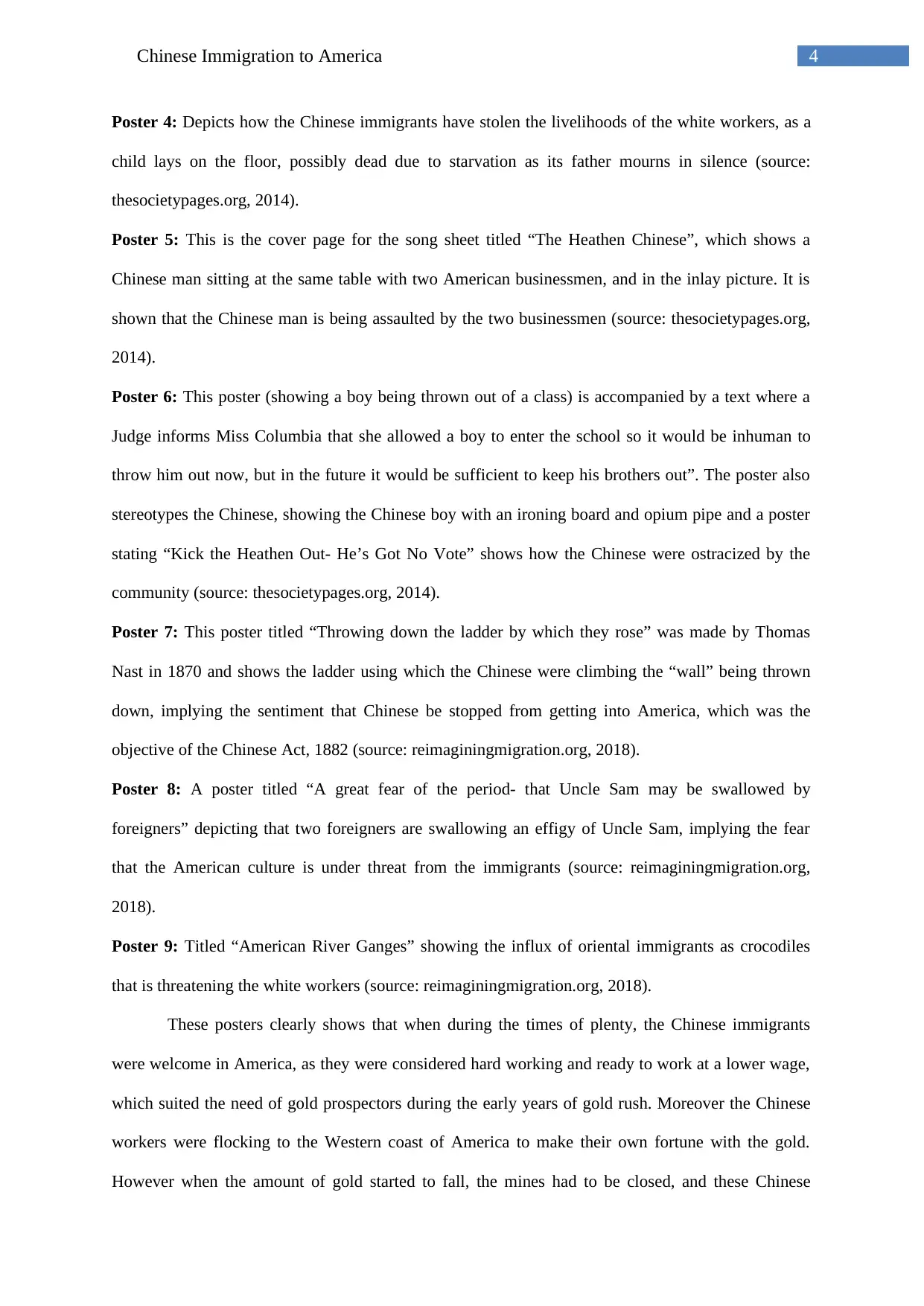
4Chinese Immigration to America
Poster 4: Depicts how the Chinese immigrants have stolen the livelihoods of the white workers, as a
child lays on the floor, possibly dead due to starvation as its father mourns in silence (source:
thesocietypages.org, 2014).
Poster 5: This is the cover page for the song sheet titled “The Heathen Chinese”, which shows a
Chinese man sitting at the same table with two American businessmen, and in the inlay picture. It is
shown that the Chinese man is being assaulted by the two businessmen (source: thesocietypages.org,
2014).
Poster 6: This poster (showing a boy being thrown out of a class) is accompanied by a text where a
Judge informs Miss Columbia that she allowed a boy to enter the school so it would be inhuman to
throw him out now, but in the future it would be sufficient to keep his brothers out”. The poster also
stereotypes the Chinese, showing the Chinese boy with an ironing board and opium pipe and a poster
stating “Kick the Heathen Out- He’s Got No Vote” shows how the Chinese were ostracized by the
community (source: thesocietypages.org, 2014).
Poster 7: This poster titled “Throwing down the ladder by which they rose” was made by Thomas
Nast in 1870 and shows the ladder using which the Chinese were climbing the “wall” being thrown
down, implying the sentiment that Chinese be stopped from getting into America, which was the
objective of the Chinese Act, 1882 (source: reimaginingmigration.org, 2018).
Poster 8: A poster titled “A great fear of the period- that Uncle Sam may be swallowed by
foreigners” depicting that two foreigners are swallowing an effigy of Uncle Sam, implying the fear
that the American culture is under threat from the immigrants (source: reimaginingmigration.org,
2018).
Poster 9: Titled “American River Ganges” showing the influx of oriental immigrants as crocodiles
that is threatening the white workers (source: reimaginingmigration.org, 2018).
These posters clearly shows that when during the times of plenty, the Chinese immigrants
were welcome in America, as they were considered hard working and ready to work at a lower wage,
which suited the need of gold prospectors during the early years of gold rush. Moreover the Chinese
workers were flocking to the Western coast of America to make their own fortune with the gold.
However when the amount of gold started to fall, the mines had to be closed, and these Chinese
Poster 4: Depicts how the Chinese immigrants have stolen the livelihoods of the white workers, as a
child lays on the floor, possibly dead due to starvation as its father mourns in silence (source:
thesocietypages.org, 2014).
Poster 5: This is the cover page for the song sheet titled “The Heathen Chinese”, which shows a
Chinese man sitting at the same table with two American businessmen, and in the inlay picture. It is
shown that the Chinese man is being assaulted by the two businessmen (source: thesocietypages.org,
2014).
Poster 6: This poster (showing a boy being thrown out of a class) is accompanied by a text where a
Judge informs Miss Columbia that she allowed a boy to enter the school so it would be inhuman to
throw him out now, but in the future it would be sufficient to keep his brothers out”. The poster also
stereotypes the Chinese, showing the Chinese boy with an ironing board and opium pipe and a poster
stating “Kick the Heathen Out- He’s Got No Vote” shows how the Chinese were ostracized by the
community (source: thesocietypages.org, 2014).
Poster 7: This poster titled “Throwing down the ladder by which they rose” was made by Thomas
Nast in 1870 and shows the ladder using which the Chinese were climbing the “wall” being thrown
down, implying the sentiment that Chinese be stopped from getting into America, which was the
objective of the Chinese Act, 1882 (source: reimaginingmigration.org, 2018).
Poster 8: A poster titled “A great fear of the period- that Uncle Sam may be swallowed by
foreigners” depicting that two foreigners are swallowing an effigy of Uncle Sam, implying the fear
that the American culture is under threat from the immigrants (source: reimaginingmigration.org,
2018).
Poster 9: Titled “American River Ganges” showing the influx of oriental immigrants as crocodiles
that is threatening the white workers (source: reimaginingmigration.org, 2018).
These posters clearly shows that when during the times of plenty, the Chinese immigrants
were welcome in America, as they were considered hard working and ready to work at a lower wage,
which suited the need of gold prospectors during the early years of gold rush. Moreover the Chinese
workers were flocking to the Western coast of America to make their own fortune with the gold.
However when the amount of gold started to fall, the mines had to be closed, and these Chinese
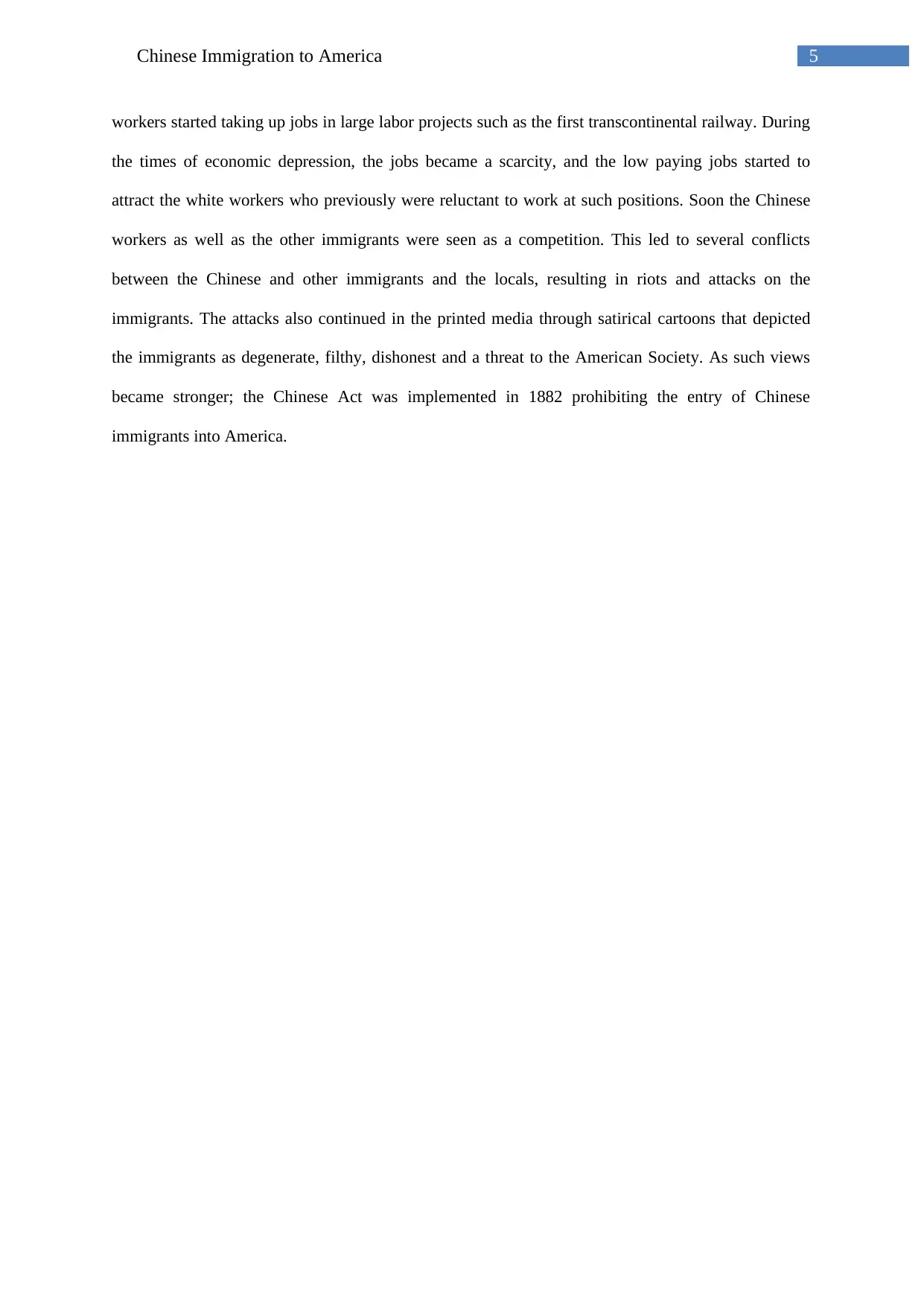
5Chinese Immigration to America
workers started taking up jobs in large labor projects such as the first transcontinental railway. During
the times of economic depression, the jobs became a scarcity, and the low paying jobs started to
attract the white workers who previously were reluctant to work at such positions. Soon the Chinese
workers as well as the other immigrants were seen as a competition. This led to several conflicts
between the Chinese and other immigrants and the locals, resulting in riots and attacks on the
immigrants. The attacks also continued in the printed media through satirical cartoons that depicted
the immigrants as degenerate, filthy, dishonest and a threat to the American Society. As such views
became stronger; the Chinese Act was implemented in 1882 prohibiting the entry of Chinese
immigrants into America.
workers started taking up jobs in large labor projects such as the first transcontinental railway. During
the times of economic depression, the jobs became a scarcity, and the low paying jobs started to
attract the white workers who previously were reluctant to work at such positions. Soon the Chinese
workers as well as the other immigrants were seen as a competition. This led to several conflicts
between the Chinese and other immigrants and the locals, resulting in riots and attacks on the
immigrants. The attacks also continued in the printed media through satirical cartoons that depicted
the immigrants as degenerate, filthy, dishonest and a threat to the American Society. As such views
became stronger; the Chinese Act was implemented in 1882 prohibiting the entry of Chinese
immigrants into America.
⊘ This is a preview!⊘
Do you want full access?
Subscribe today to unlock all pages.

Trusted by 1+ million students worldwide
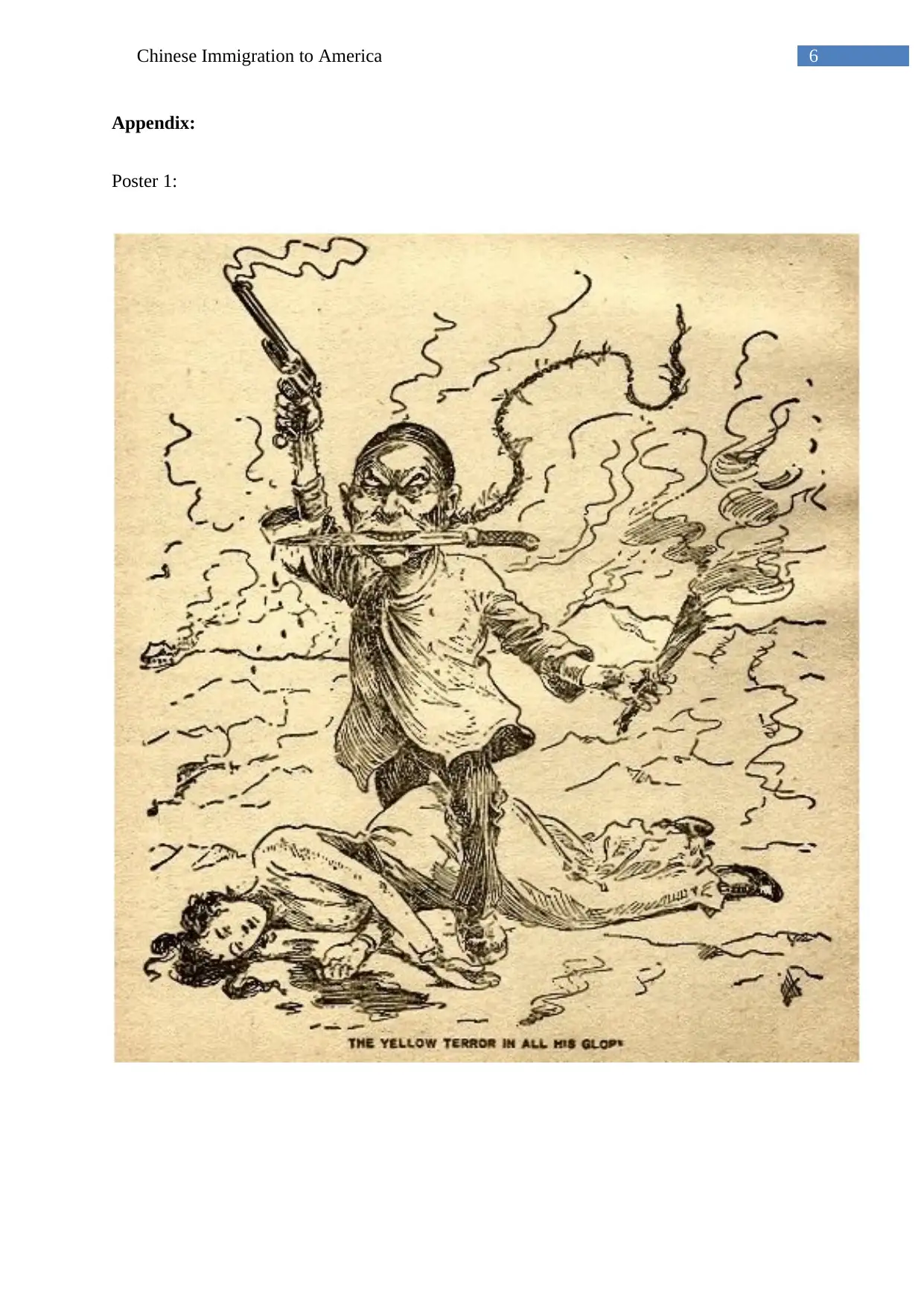
6Chinese Immigration to America
Appendix:
Poster 1:
Appendix:
Poster 1:
Paraphrase This Document
Need a fresh take? Get an instant paraphrase of this document with our AI Paraphraser
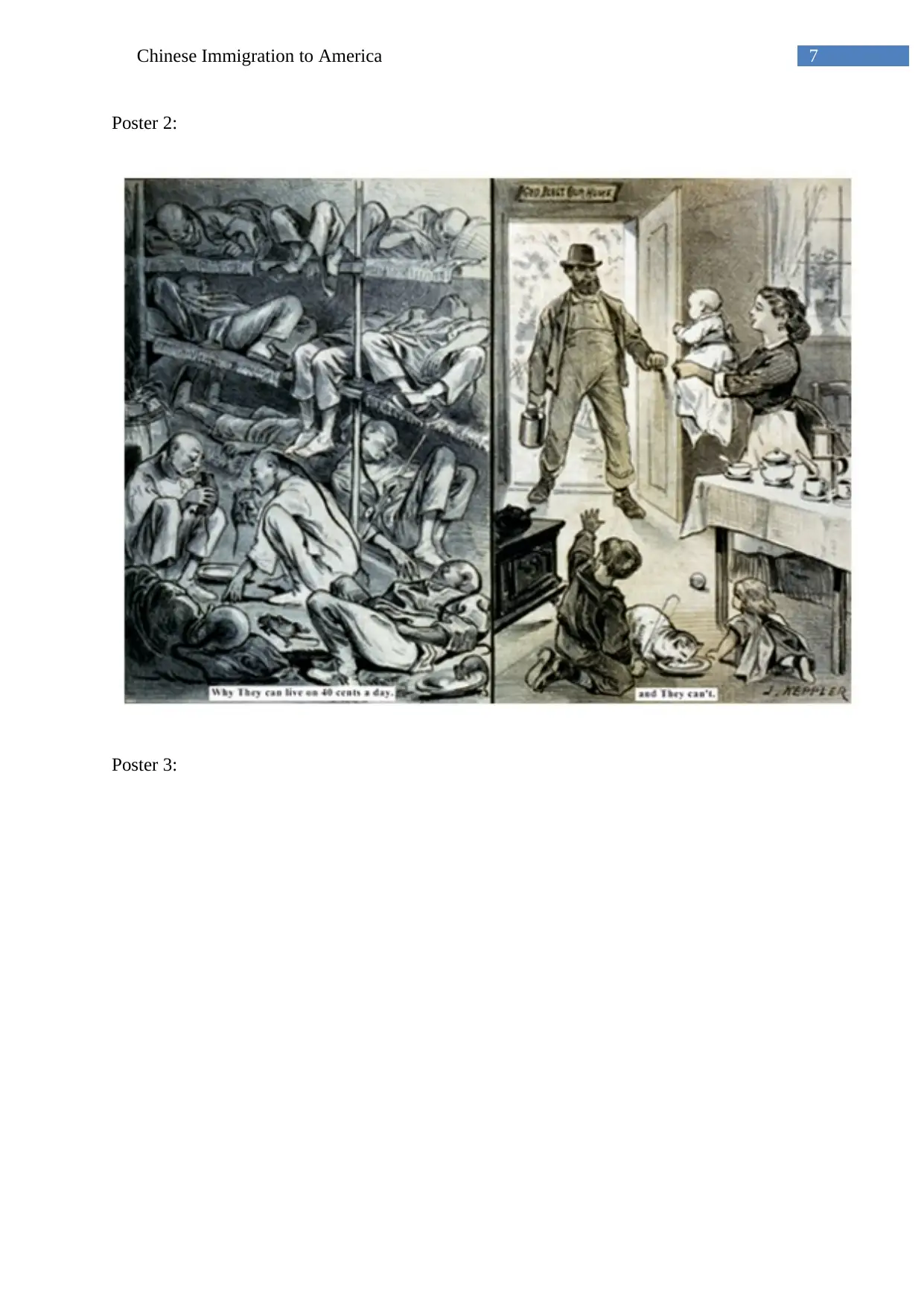
7Chinese Immigration to America
Poster 2:
Poster 3:
Poster 2:
Poster 3:
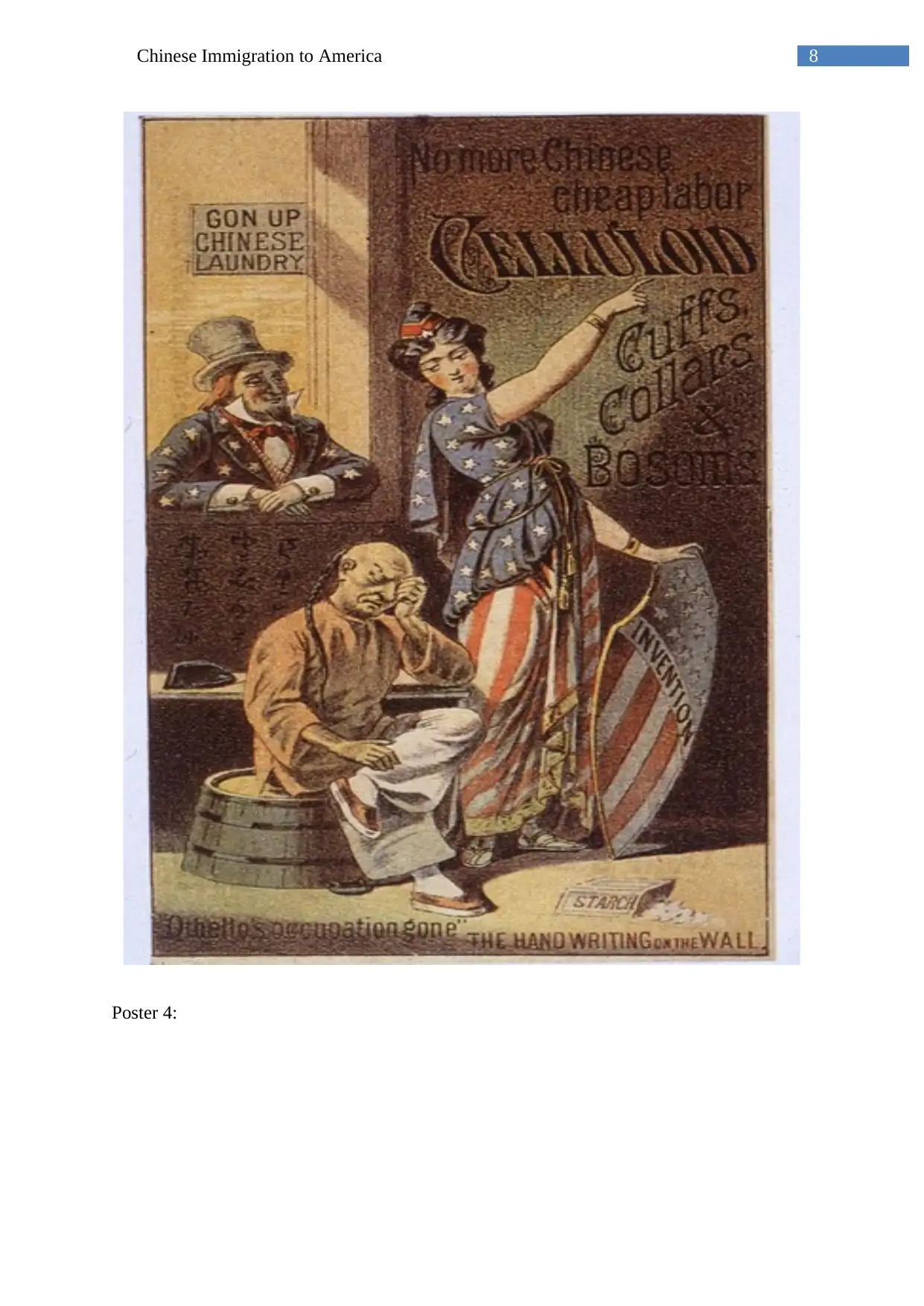
8Chinese Immigration to America
Poster 4:
Poster 4:
⊘ This is a preview!⊘
Do you want full access?
Subscribe today to unlock all pages.

Trusted by 1+ million students worldwide
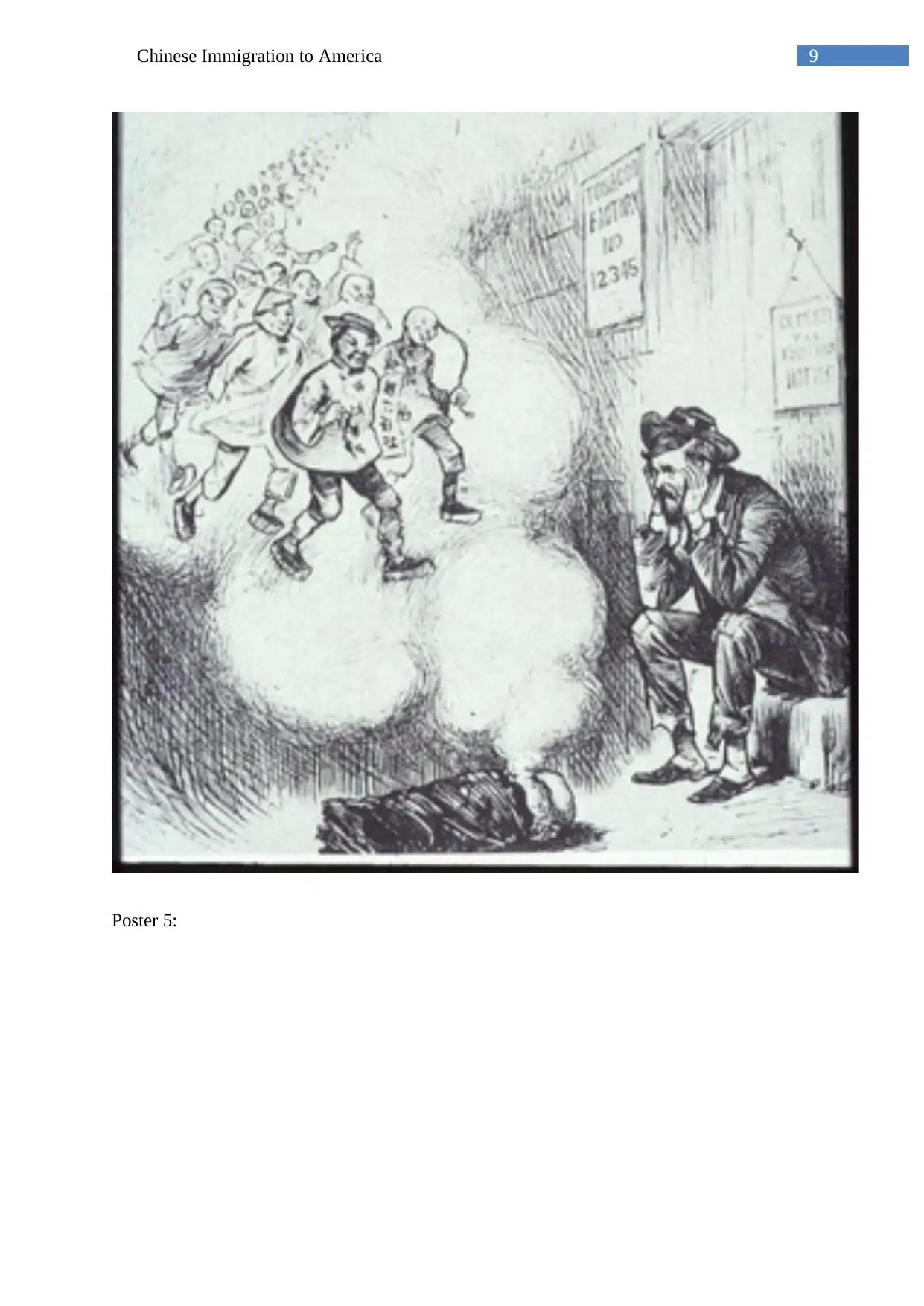
9Chinese Immigration to America
Poster 5:
Poster 5:
Paraphrase This Document
Need a fresh take? Get an instant paraphrase of this document with our AI Paraphraser
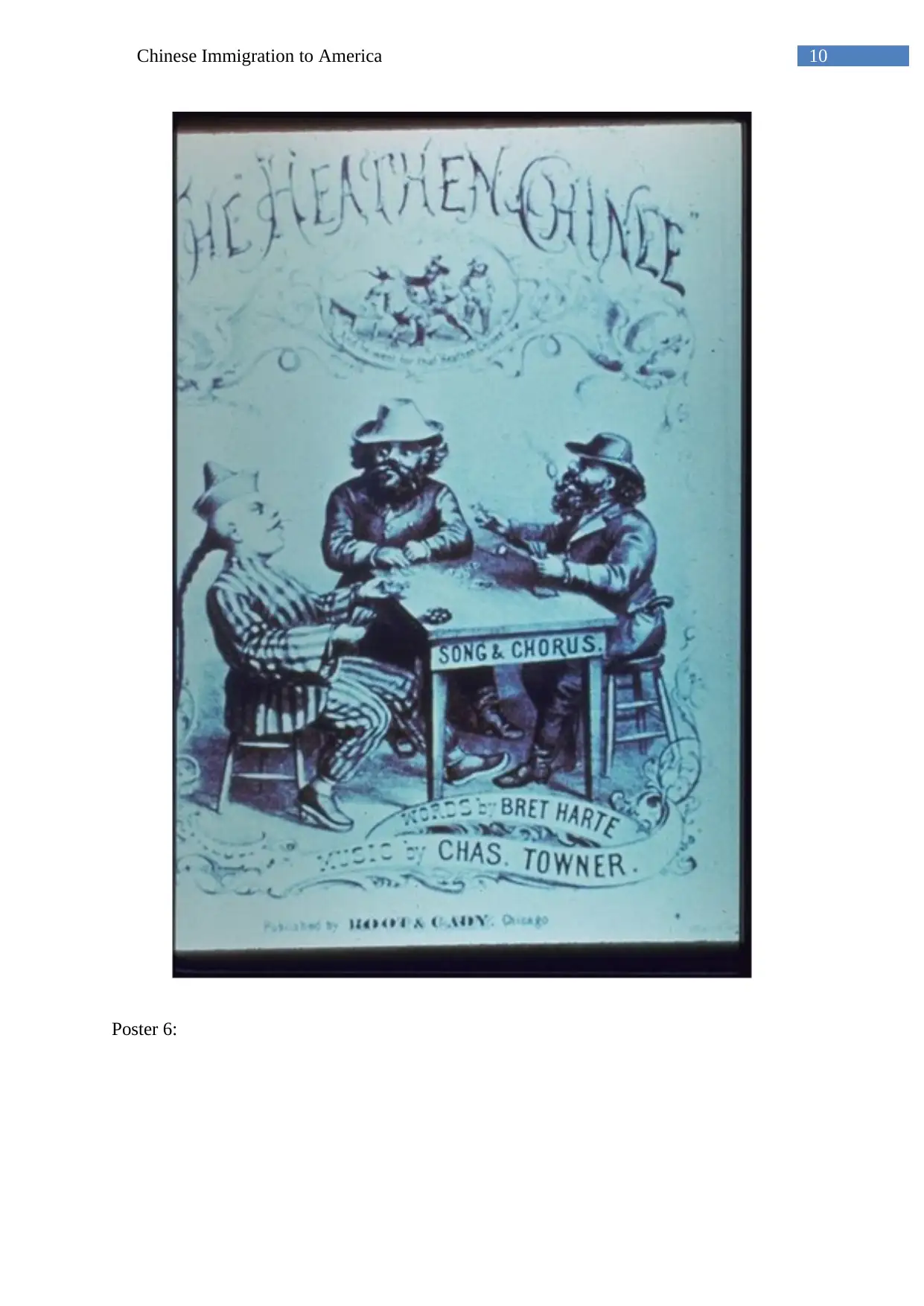
10Chinese Immigration to America
Poster 6:
Poster 6:
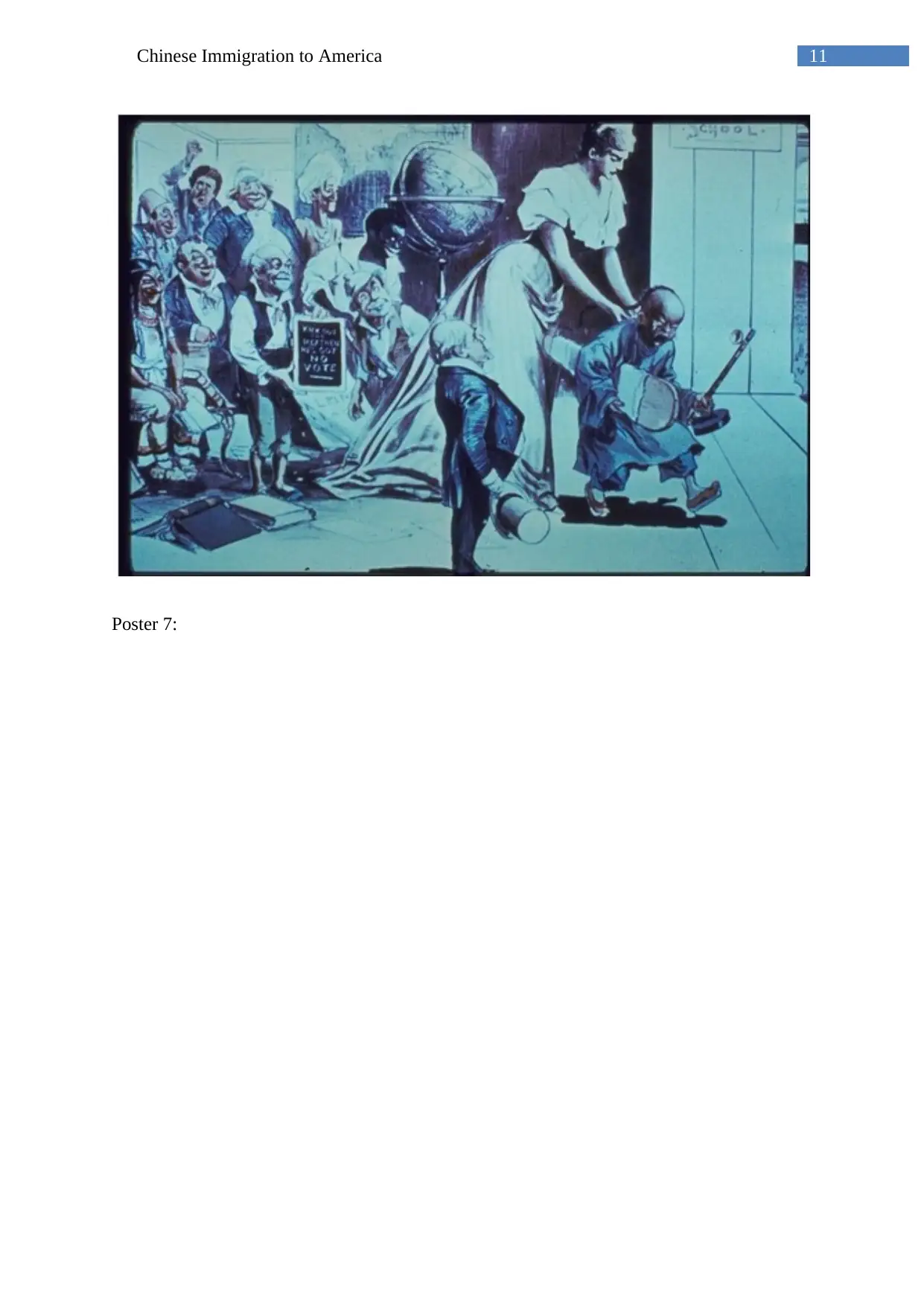
11Chinese Immigration to America
Poster 7:
Poster 7:
⊘ This is a preview!⊘
Do you want full access?
Subscribe today to unlock all pages.

Trusted by 1+ million students worldwide
1 out of 18
Your All-in-One AI-Powered Toolkit for Academic Success.
+13062052269
info@desklib.com
Available 24*7 on WhatsApp / Email
![[object Object]](/_next/static/media/star-bottom.7253800d.svg)
Unlock your academic potential
Copyright © 2020–2025 A2Z Services. All Rights Reserved. Developed and managed by ZUCOL.